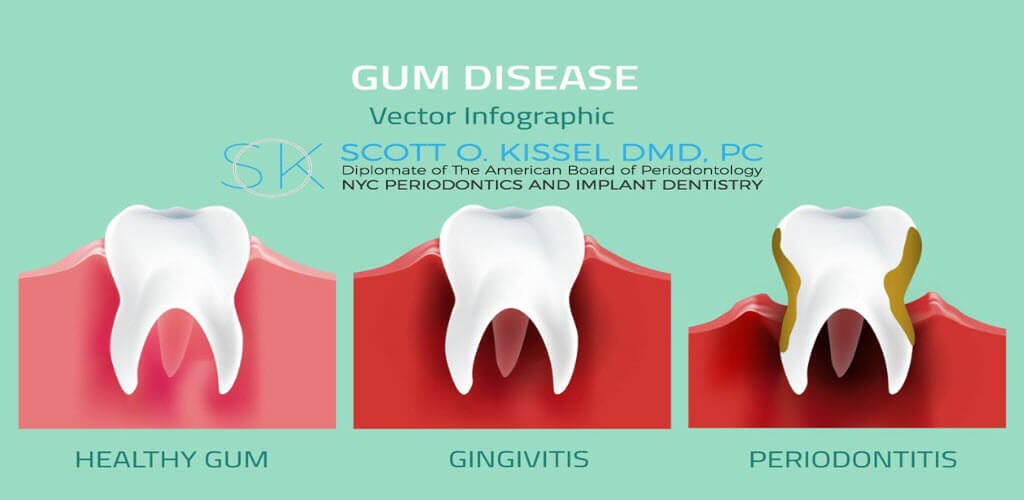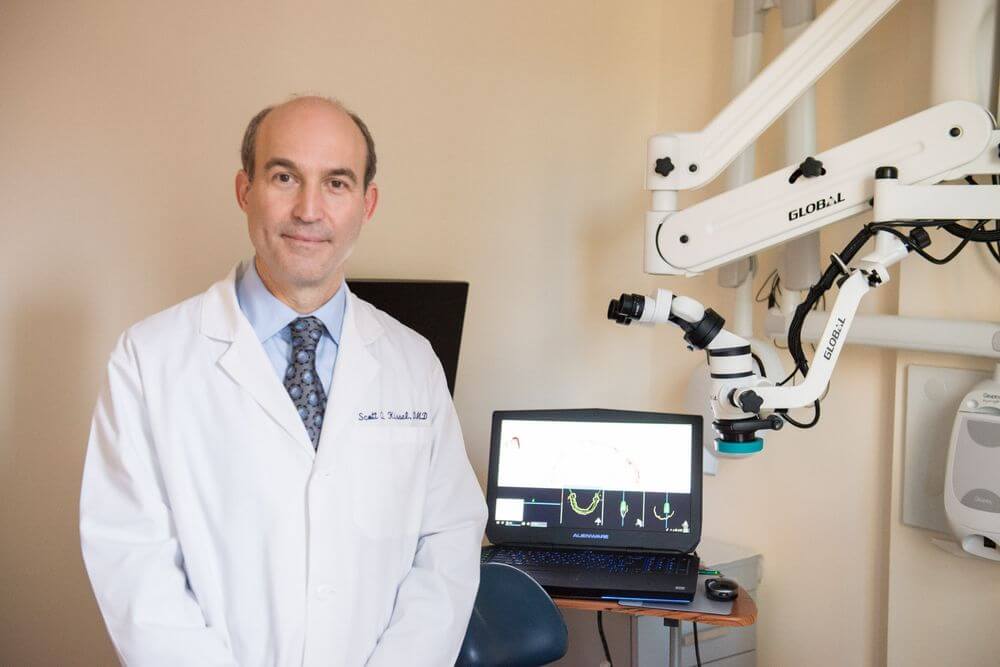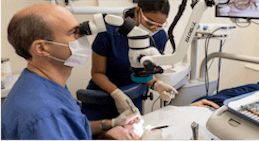As a periodontist in Midtown Manhattan, New York City, Dr Kissel strives to provide his patients with the most effective and least invasive treatment solutions possible. That’s why he is a strong advocate for dental microsurgery – a revolutionary technique offering superior results compared to traditional gum disease treatments.
We would like to explore why dental microsurgery is able to make a significant difference in how gum disease can be treated.
What is Gum Disease?
Gum disease, also known as periodontal disease, is a chronic inflammatory condition affecting the tissues that support your teeth. It’s caused by a buildup of plaque, a sticky film teeming with bacteria, at the gum line. If left unchecked, plaque hardens into tartar (calculus), further irritating the gums. This irritation triggers an inflammatory response, leading to the hallmark symptoms of gum disease: red, swollen, and bleeding gums. In advanced stages, gum disease can cause gum recession, bone loss, and even tooth loss. Early detection and treatment are crucial to prevent these complications and maintain a healthy smile.

Traditional Gum Surgery vs. Dental Microsurgery: A World of Difference
Traditionally, gum surgery relies on visualization with the naked eye. While effective in many cases, this approach necessitates larger incisions and sutures. This can lead to increased discomfort, bleeding, and a longer healing process. Additionally, manipulating delicate gum tissue with standard instruments can sometimes lead to unintended consequences, impacting long-term outcomes.
Dental microsurgery revolutionizes gum treatment by incorporating a high-powered surgical microscope. This microscope provides exceptional magnification, allowing me to visualize the treatment area in unprecedented detail. With this level of precision, I can utilize incredibly fine instruments and sutures, minimizing tissue manipulation and promoting faster healing with minimal discomfort.
The Benefits of Dental Microsurgery for Gum Disease Treatment
When it comes to treating gum disease, achieving optimal results extends far beyond simply eliminating the infection. Here at Dr Kissel’s Manhattan periodontal office, he prioritizes not only halting the disease’s progression but also promoting long-term gum health and aesthetics. Dental microsurgery empowers him to achieve this goal by offering a multitude of benefits that traditional procedures simply cannot match. Let’s examine how this innovative approach elevates the treatment of gum disease.
Enhanced Diagnosis
While dentists can identify the presence of gum disease through visual inspection and probing, the naked eye has limitations. Crucial details like the precise location and extent of infection, the presence of pockets or deep crevices, and the condition of underlying bone can be missed.
Dental microsurgery changes the level of detail that can be gathered and utilized to treat gum disease. The high-powered microscope acts like a high-resolution satellite image, revealing the intricate details of the treatment area. This enhanced visualization allows Dr Kissel to:
- Identify Microscopic Issues: Early signs of gum disease, like incipient pockets or subtle gum recession, become readily apparent. Early detection is crucial for prompt intervention and preventing further damage.
- Pinpoint the Extent of Infection: He can accurately map the spread of gum disease, both horizontally (affecting the gum tissue) and vertically (affecting the underlying bone). This detailed understanding allows for a more targeted treatment plan, maximizing effectiveness and minimizing unnecessary procedures.
- Differentiate Healthy vs. Diseased Tissue: Healthy gum tissue appears pink and firm, while diseased tissue might be red, inflamed, or receding. Microscopic visualization allows for a finer distinction between these tissues, enabling me to preserve healthy gum tissue while meticulously removing diseased areas.
- Assess Bone Health: The microscope allows him to see the underlying bone structure in greater detail. This is crucial for identifying areas of bone loss and planning for potential bone grafting procedures if needed.
By providing a “bird’s-eye view” within the microscopic world, dental microsurgery empowers him to make a more accurate diagnosis and develop a personalized treatment plan tailored to your specific needs. This precise understanding of your gum disease translates into a more effective and predictable treatment course for a healthier, more stable smile.
Minimally Invasive Procedures
Dental microsurgery revolutionizes gum disease treatment by embracing the philosophy of “less is more.” Here’s how it minimizes invasiveness:
- Precision Cuts: The magnified view allows for incredibly precise incisions, minimizing the amount of healthy tissue that needs to be manipulated. This translates to less bleeding, swelling, and discomfort after surgery.
- Finer Sutures: With microscopic visualization, Dr Kissel can utilize much finer sutures compared to traditional techniques. These finer sutures cause less irritation and discomfort while promoting faster healing and a more aesthetically pleasing result.
- Targeted Treatment: The magnified view allows for a targeted approach to diseased tissue. This minimizes the disruption to healthy surrounding tissues, promoting faster healing and a quicker return to normal function.
The benefits of minimally invasive procedures extend beyond immediate comfort. Faster healing times minimize disruption to your daily routine, and the reduced risk of infection promotes a smoother overall recovery process. Additionally, by minimizing tissue manipulation, dental microsurgery can help preserve the natural contours of your gums, leading to a more natural-looking smile after treatment.
Preservation of Healthy Tissue
When it comes to gum disease treatment, achieving a healthy outcome doesn’t just mean eliminating the infection – it also means preserving the healthy tissues that are crucial for long-term gum health and stability. Traditional gum surgery techniques, due to their reliance on larger incisions and less precise manipulation, can sometimes inadvertently damage surrounding healthy gum tissue. This can lead to several drawbacks:
- Increased Risk of Recession: Unintentional damage to healthy gum tissue can contribute to gum recession, exposing the sensitive root surfaces of teeth. This can lead to increased sensitivity, aesthetic concerns, and even potential bone loss over time.
- Compromised Aesthetics: Healthy gum tissue plays a vital role in framing the teeth and creating a natural, balanced smile. Unnecessary manipulation or damage during surgery can negatively impact the aesthetics of your smile.
- Reduced Long-Term Stability: Healthy gum tissue provides crucial support for the teeth. If healthy tissue is compromised during surgery, it can weaken the foundation of your smile and potentially increase the risk of future problems.
Dental microsurgery addresses these concerns by prioritizing the preservation of healthy gum tissue. Here’s how:
- Microscopic Visualization: The high-powered microscope allows Dr Kissel to meticulously distinguish healthy tissue from diseased tissue. This enables him to target the infected areas with extreme precision, minimizing the risk of accidental damage to healthy surrounding tissues.
- Delicate Instruments: Working under magnification allows him to utilize incredibly fine surgical instruments. These instruments provide greater control and precision for removing diseased tissue while minimizing manipulation of healthy gum tissue.
- Flap Management Techniques: Many gum procedures involve lifting and manipulating gum flaps to access the underlying bone. With microsurgery, he can perform these procedures with utmost precision, ensuring the flaps are meticulously lifted, repositioned, and sutured back in place with minimal trauma to the healthy tissue.
By prioritizing the preservation of healthy gum tissue, dental microsurgery promotes faster healing, minimizes aesthetic concerns, and creates a more stable foundation for your teeth. This meticulous approach ensures long-term gum health and a beautiful smile you can be confident in.
Is Dental Microsurgery Right for You?
Dental microsurgery offers a wide range of benefits for gum disease treatment. However, the best course of treatment will vary depending on your individual needs and condition.
Here are some signs that dental microsurgery might be right for you:
- You are experiencing advanced gum disease with significant bone loss.
- You require delicate procedures like gum grafting or reconstructive surgery.
- You are interested in minimally invasive and precise treatment options.
Schedule a Consultation with Dr. Kissel Today
If you have been diagnosed or have symptoms of gum disease, you should schedule a consultation with Dr Kissel at his Midtown Manhattan periodontal office. During this consultation, he will thoroughly assess your oral health needs and discuss the potential benefits of dental microsurgery. Together, you can create a personalized treatment plan designed to achieve optimal results and a healthy, beautiful smile.

Consulting with an NYC board-certified periodontist, like Dr Kissel who is always up-to-date with new treatments and procedures, you will receive periodontal care that is backed by current research. If you have periodontal issues, contact him to book your consultation. With advanced training in periodontitis / gum disease, laser surgery, and microscopic procedures, he can offer you minimally invasive techniques that provide better precision, comfort, and results. He also provides a variety of amenities and resources to make your experience in his periodontal office more comfortable and relaxing. Call his Madison Avenue periodontal office in New York City for a consultation at (347) 758-9790.
